Makki Ki Roti (Cornmeal Flatbread), a winter delicacy from the Punjab region of Pakistan and India, is traditionally paired with sarson-ka-saag-mustard-greens. Traditionally a difficult recipe to perfect, my recipe breaks down the steps and simplifies the technique so that even beginners will get perfect results!
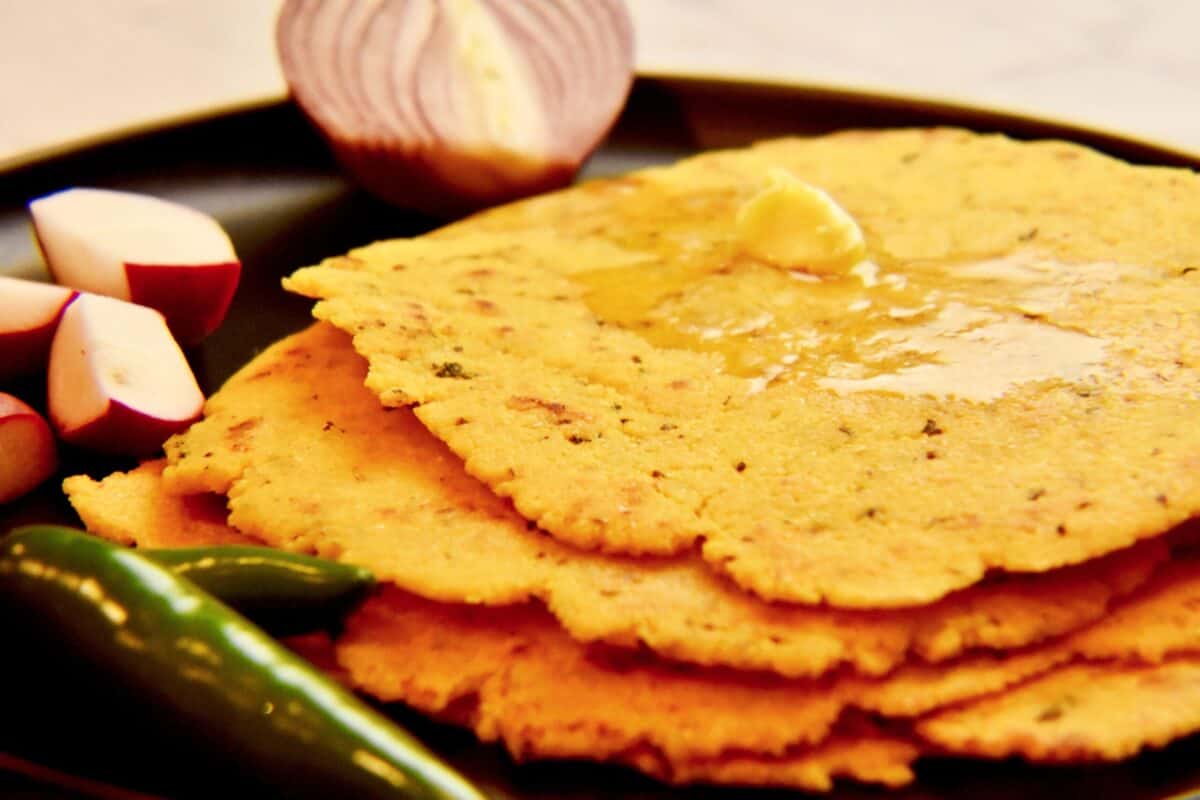
WANT TO SAVE THIS RECIPE?
The mild, slightly sweet taste of the Makki Ki Roti marries well with the sharp taste of the Mustard Greens. You can't imagine eating either alone once you fall in love with this pairing.
I didn't attempt making Makki ki Roti for many years as I knew it was a tricky process. Due to the grainy texture of the cornmeal, the dough is difficult to handle. However, following all the tips and suggestions I've provided below, you'll have the perfect rotis on your table quickly!
If you want a fun holiday twist on this recipe, try my makki ki roti tart shells. Another unusual but delicious Pakistani flatbread to try is missi roti (besan ki roti), made with chickpea and whole-wheat flour.
Jump to:
Why you'll love this recipe
- Nutritious Breakfast - Makki ki Roti is high in fiber and gluten-free if made without the addition of any atta. Highly nutritious, with Vitamin A, C, K, and B Complex; according to ndtv.com, cornmeal is an excellent source of energy. Served with a dollop of freshly churned butter and a steaming hot cup of tea, it makes for a delicious breakfast in winter, just like my perfect shami kabab recipe.
- Easy Method - The method detailed below, which uses two sheets of parchment paper and a saucepan to flatten the ball of dough, makes it so easy to handle the dough that all the stress is removed from the entire process of making the rotis.
- Gluten-free option - I've provided the option of adding atta to make the dough more pliable and easy to handle. However, traditionally, makki ki roti is made with cornmeal alone, making it gluten-free. Swap the atta for cornmeal in the recipe below, and the roti is completely gluten-free, just like my authentic chana masala recipe.
Ingredient notes

- Cornmeal - Cornmeal is a coarse flour made from dried corn and is easily available at supermarkets.
- Atta - This flour is used to make South Asian flatbreads and is available at specialty stores or online stores. This flour is derived from hard wheat, and the milling process differs from the regular wheat flour found in US supermarkets, so substituting it is not recommended.
- Fenugreek - Dried fenugreek leaves are recommended for flavor and aroma, but if you can't source these, feel free to omit them.
- Carom - Carom seeds, known as 'ajwain' in Pakistan's native language, Urdu, are delicious, fragrant, and good for digestion. They're added for flavor and to help aid with digestion. However, as with the fenugreek leaves, they can be omitted.
- Ghee - I like to use ghee for my roti, as is traditional. Its nutty, intense flavor is perfect for this recipe, but feel free to use a regular high-heat index cooking oil of your choice instead.
- Butter - A small dollop of butter on a fresh, hot makki ki roti is essential just before it's served. It keeps the roti moist and tastes absolutely amazing.
Please see the recipe card at the bottom of this post for the complete list of ingredients with measurements plus recipe instructions.
Substitutions & variations
- Add grated daikon radish to your roti - Daikon radish is another winter specialty, and what better way to enjoy the two than to combine them for a delicious and filling breakfast?
- Add spinach to it - Chopped and cooked spinach can be added to the dough. Just make sure to squeeze all the water out of it so the dough doesn't get too sticky.
- Have the roti for breakfast with plain yogurt and tea - Fresh homemade yogurt, a steaming cup of chai, and a makki ki roti make for a delicious breakfast.
- Use a frying pan - No tawa(griddle for flatbread)? Just use a non-stick frying pan. It works great as a substitute.
Step-by-step instructions
Prepping the rotis

First step - If you're new to making makki ki roti, I recommend adding ¼ cup atta to the dough. It will make it easier to handle the dough. As you get more adept at making these, you can replace that ¼ cup with cornmeal.
Second step - Gather all of your tools and shape the dough into 5 even balls, making sure there are no cracks in them. Due to the crumbly nature of the dough, it's difficult to shape the roti with a rolling pin alone. This is where the parchment paper and saucepan will help.
Third step - Take a piece of parchment paper and place a ball of dough on it. Cover with a second sheet of parchment and slightly flatten the ball with your hand to form a thick disc.
Fourth step - Press down with the saucepan to make an even round that's thinner than the disc. Using the saucepan puts even pressure on the disc, and in my experience, this prevents cracks.
Finishing the rotis

Fifth step - Finally, make your circle larger and a little thinner using your rolling pin. Make sure not to flatten the edges too much, as this will make it difficult to peel the roti off the parchment paper.
Sixth step - You will find that the edges are a little uneven. This is typical of this type of flatbread due to the texture of the dough. Gently peel the top layer of the parchment off. If it seems to be sticking to the roti too much, it's likely because the dough has become sticky after all the rolling. Just stick it in the fridge for a few minutes and then try again rather than breaking the flatbread and having to start all over again.
Seventh step - Transfer the roti onto your tawa by flipping it onto the griddle and gently peeling the parchment off. This part is tricky as the heat from the tawa makes the dough sticky and easy to break.
Eighth step - Cook the roti for 2-3 minutes on each side maximum. Use a little bit of oil if needed to prevent it from sticking to the pan. The roti is done when the color changes to a deep yellow and some brown flecks appear on the surface. Place your cooked roti in a serving dish, add 1-2 teaspoons of butter on top, and enjoy!
Expert Tips
- Keep some oil nearby - I keep a small bowl of ghee or oil and periodically dip my hands in it to help shape my dough into smooth balls.
- Chill the dough - Do this for 5 minutes after you knead the dough. As the ghee solidifies, it becomes easier to shape the dough.
- Preheat the tawa - Before you start shaping your first roti, set your tawa or pan on the stove to preheat. High heat and rapid cooking will keep your rotis soft.
- Keep a clean napkin on hand - If your roti starts to break or crack as you transfer it to the tawa, gently press down and seal the broken pieces together with the napkin. You'll have to be quick and do this before the flatbread starts to cook, and this becomes impossible.
- Use a nonstick Tawa - This will make it easier to handle the flatbread. If your Tawa or pan is not nonstick, use oil (no more than 1-2 teaspoons) while cooking the roti to prevent it from sticking to the pan.
Recipe FAQS
No, cornflour is very finely ground and won't result in the right texture. I like to use cornmeal for my Makki ki Roti as it's ground a little coarser and tastes more like the makki ka atta (corn flour) we use in Pakistan.
Once the rotis are cooked, keep them in a soft, clean tea towel to keep them moist if you're not eating immediately. It's best to cook and eat the flatbread right away. You can store them in the fridge for 2 days maximum and in the deep freezer for up to 2 months. Make sure to place them in a ziploc bag and seal it tightly.
If frozen, defrost the rotis in the fridge overnight. The best method is to reheat the rotis on a tawa or frying pan for 2-3 minutes with a little bit of ghee or cooking oil. They can be wrapped in a damp paper towel and heated for about 30 seconds per 5 rotis, but this can make them a bit chewy, so the stovetop method is the best way to reheat them.
Make sure to knead your dough for 5-6 minutes and let it rest for 8-10 minutes. Once you're ready to cook, preheat your tawa and cook the rotis on high heat. These steps should result in rotis that are crispy on the outside and soft on the inside.

Other recipes you may like
For more Pakistani recipes like this, check out 20 popular Pakistani recipes. If you decide to try this recipe, Please don't forget to leave a rating and comment below! If you take a picture then tag me on Instagram! Thank You!
Makki Ki Roti (Cornmeal Flatbread)
WANT TO SAVE THIS RECIPE?
Ingredients
- 1 ¼ cup cornmeal
- ¼ cup atta (see notes)
- 1 teaspoon salt
- ½ teaspoon red chili powder
- 1 tablespoon dried fenugreek leaves (see notes)
- 1 tablespoon ajwain (see notes)
- 2 tbsps ghee
- 1 cup water
- 5 tsps butter
Instructions
- Mix all ingredients except the butter with your hands, kneading for 5-6 minutes to get a smooth dough.
- Chill the dough for 8-10 minutes as this makes it easier to shape the balls of dough.
- Shape the dough into five even balls. (see notes)
- Transfer the dough to a sheet of parchment, one ball at a time.
- Cover with a second sheet of parchment.
- Press down gently with a saucepan to make a small disc.
- Use the rolling pin to gently flatten the disc shape you've made, trying to avoid cracking the roti.
- Roll the roti out to a circumference of 4 inches.
- Peel off the top sheet of parchment.
- Transfer the roti using the remaining parchment sheet onto your preheated tawa/frying pan and then peel the parchment off gently. (see notes)
- Cook for 2-3 minutes on each side, until the roti is a deep yellow with some brown flecks on the surface.
- Place your cooked roti on a plate, place 1 teaspoon of butter on top and enjoy.



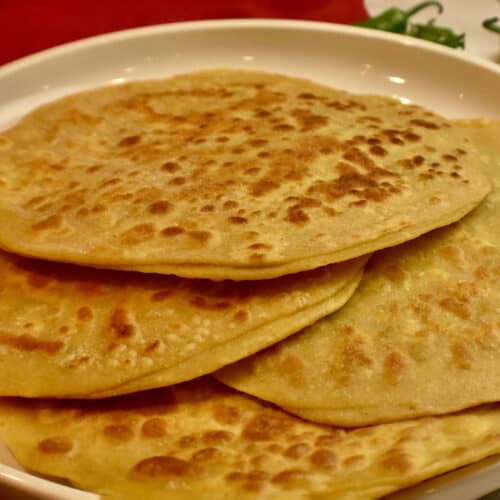
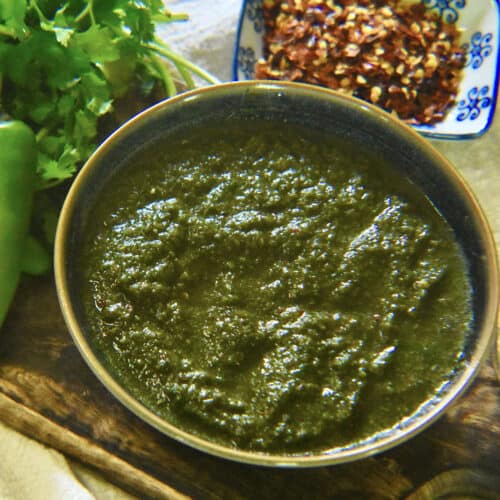
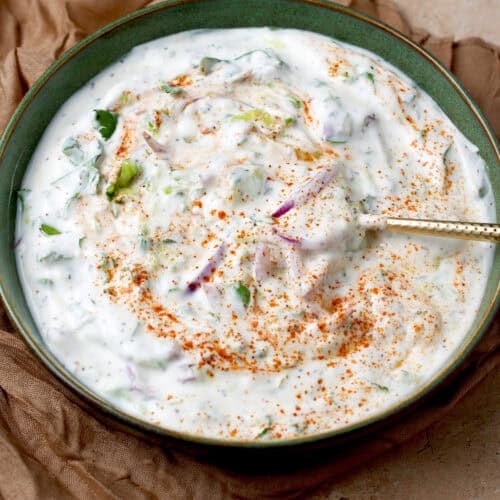


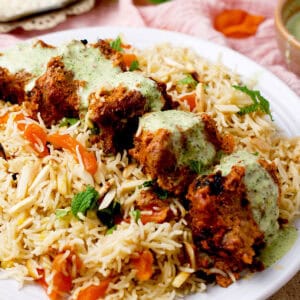
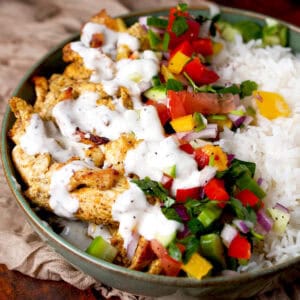
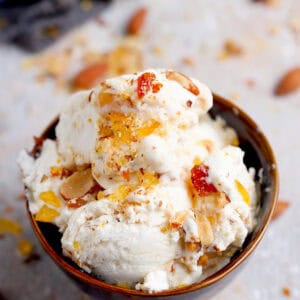
Leave a Reply